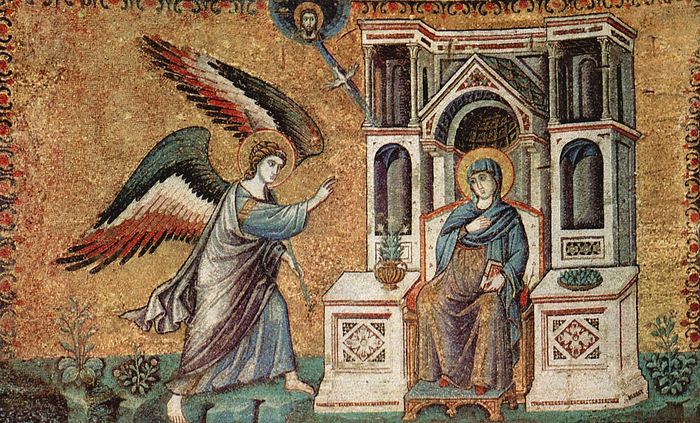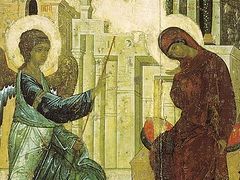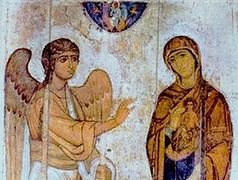 Annunciation by Pietro Cavallini, ca. 1291
Annunciation by Pietro Cavallini, ca. 1291
The Annunciation: 1. One of the most important events in the Gospel, in which the Archangel Gabriel announced to the Virgin Mary that by the will of God She must give birth to the Savior of the world and She agreed to become the Mother of God by human nature. 2. One of the Twelve Great Feasts of the Orthodox Church which is dedicated to this event and solemnly celebrated by the faithful annually on March 25/April 7.
What is so special about the Annunciation and why is this event celebrated as one of the most important feasts of the Church?
At the Annunciation the Angel brought the Glad Tidings to the Virgin Mary: seeing that She was the Most Pure and godly Maiden Who was worthy of becoming the Mother of God by human nature, the Lord announced the approaching Incarnation of God’s Word (the Logos) through Her.
At that moment the possibility of the Birth of the Savior of the world depended only on the acceptance of God’s chosen Maiden of Her role. And She consented to become the Mother of Christ: Behold the Handmaid of the Lord; be it unto Me according to thy word (Lk. 1:38).
The Holy Fathers and Teachers of the Orthodox Church compared this humble and meek answer to the words of Christ, Who expressed His acceptance of God the Father’s will over His own during His prayer in the Garden of Gethsemane: not as I will, but as Thou wilt (Mt. 26:39).
Why did God choose Mary to give birth to Jesus Christ?
Firstly, by Her ancestry She met the Biblical requirement, according to which Christ, the Savior of the world, should be born of the seed of Abraham, and of the tribe of Judah, and of the blood line of David. And, secondly and most importantly, She like nobody else satisfied the spiritual and moral requirements necessary for the fulfilment of Her mission.
As She grew up, the Virgin Mary, Who had been dedicated to God and entrusted to the Temple by her parents, devoted Her entire time to the service of God: She prayed much, labored and studied the Holy Scriptures. Thus She was the only human being (of course, apart from Her Divine Son) to be called “the Most Pure” in an exclusive and the most sublime sense of the word.
Tradition holds that the Theotokos remained free of personal sin and calls Her “Immaculate” (in the sense “undefiled”, “spotless”) and “Most Holy”. The Church honors and glorifies Her as “Heaven”, “the Ark of God”, “a Gate of Salvation”, “the Flowering Rod”, “the Altar of the Almighty”.
It is also noteworthy that the Virgin Mary surpassed in godliness not only all women, but also all people who have ever lived in the world. In iconography, notably in the scenes of the Ascension of the Lord, the Mother of God is sometimes depicted as having a nimbus, whereas the apostles are depicted without halos.



